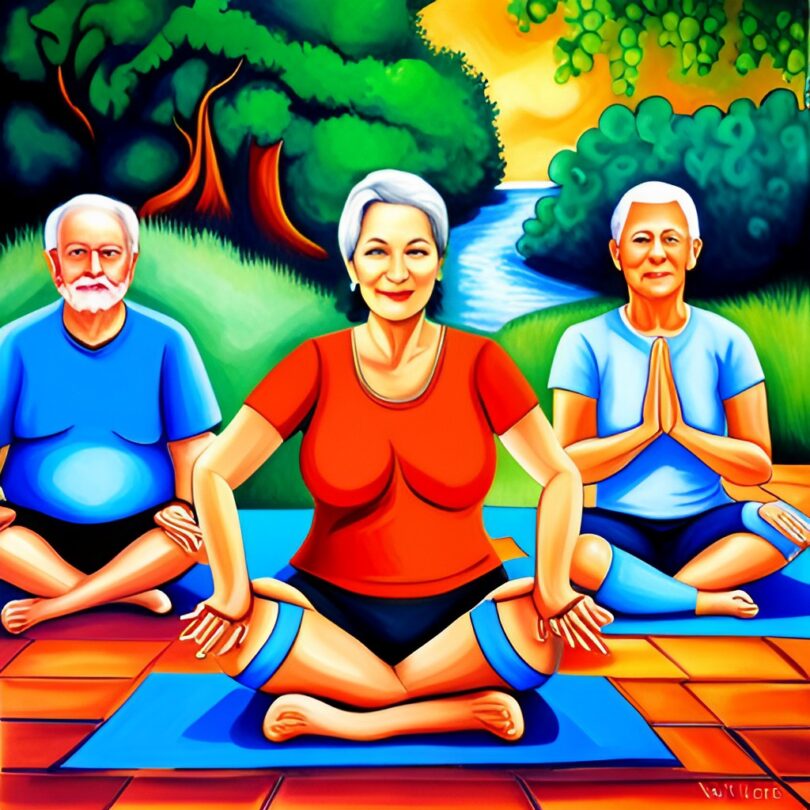Table of Contents
Introduction
As we gracefully age, the importance of maintaining a healthy and active lifestyle becomes paramount. One practice that has gained significant popularity among seniors is yoga. In this article, we’ll delve into the art of teaching yoga to seniors, exploring the benefits, tailored approaches, and the unique considerations that come with instructing an older demographic.
Understanding the Unique Needs of Seniors
Teaching yoga to seniors requires a nuanced approach, considering their physical limitations and health concerns. Unlike a one-size-fits-all approach, senior yoga instructors must customize their sessions to accommodate individual needs and abilities. This involves understanding the unique challenges seniors may face and adapting yoga practices accordingly.
Tailoring Asanas for Seniors
Traditional yoga poses may need modification for seniors to ensure safety and comfort. Gentle movements, flexibility exercises, and modified poses can cater to the specific needs of aging bodies. It’s essential to focus on enhancing mobility, maintaining balance, and improving overall flexibility while avoiding strenuous positions that may lead to injuries.
Incorporating Mindfulness and Relaxation Techniques
Beyond the physical benefits, yoga for seniors should emphasize mental well-being. Introducing mindfulness practices, meditation, and breathing exercises can contribute significantly to stress reduction and improved mental health. Seniors often find solace and tranquility through these practices, enhancing their overall quality of life.
Creating a Safe Environment
To facilitate a positive yoga experience for seniors, it’s crucial to create a safe and accessible environment. This includes choosing suitable venues, providing necessary props for support, and ensuring that the space is conducive to the needs of older participants. A thoughtful setup contributes to a sense of security and encourages seniors to explore their yoga practice more freely.
Building a Sense of Community
Seniors, like any other age group, thrive in a supportive community. In yoga classes tailored for older individuals, fostering a sense of community is paramount. Instructors should encourage social interaction, create opportunities for connection, and establish an inclusive atmosphere where everyone feels welcome and valued.
Addressing Common Concerns
It’s common for seniors to harbor concerns about their physical abilities when considering yoga. Instructors must address these apprehensions, debunking myths about age limitations in yoga. Assuring seniors that yoga is adaptable and beneficial for all fitness levels can help alleviate anxieties and encourage participation.
The Role of Certified Instructors
When embarking on a senior yoga journey, it’s essential to seek guidance from certified instructors with expertise in this specific field. Instructors should possess qualifications that reflect their understanding of the unique needs of seniors, ensuring a safe and effective practice for participants.
Success Stories and Testimonials
Real-life success stories from seniors who have embraced yoga can be a powerful motivator. Sharing these stories illustrates the tangible benefits of a consistent yoga practice, inspiring others to embark on their journey to improved health and well-being in their golden years.
Incorporating Technology in Senior Yoga Classes
In today’s digital age, technology can be a valuable tool for connecting seniors with yoga instructors. Exploring virtual classes and online resources makes yoga more accessible to seniors, even those who may face challenges with mobility or transportation.
Related Article : Chair Yoga for Weight Loss for Seniors
Promoting Long-Term Health Benefits
The positive impact of yoga on longevity cannot be overstated. By promoting physical and mental well-being, yoga becomes a holistic approach to healthy aging. Encouraging seniors to view yoga as a long-term investment in their health can lead to sustained well-being in their later years.
Partnering with Senior Care Facilities
Collaborating with senior care facilities, retirement homes, and assisted living communities can bring the benefits of yoga directly to those in need. Integrating yoga into daily routines within these settings offers seniors a structured and supportive environment to practice regularly.
Overcoming Age-Related Challenges
Certain age-related conditions like arthritis and osteoporosis require specialized attention. Instructors should be knowledgeable about adapting yoga practices to accommodate these challenges, ensuring a safe and beneficial experience for seniors with specific health concerns.
Encouraging Family Participation
Involving family members in senior yoga sessions creates a strong support network. Encouraging intergenerational participation fosters connection and shared experiences, making the yoga journey more enjoyable and sustainable for seniors.
FAQs
Is yoga safe for all seniors, regardless of their fitness levels?
Yes, yoga can be adapted for individuals of varying fitness levels. Certified instructors can modify practices to suit each participant’s needs.
How often should seniors practice yoga for optimal benefits?
Consistency is key. Seniors can benefit from practicing yoga at least 2-3 times a week for noticeable improvements in flexibility, balance, and mental well-being.
Are there specific poses that should be avoided by seniors with certain health conditions?
Yes, seniors with specific health conditions should consult with their healthcare providers and inform their yoga instructors to avoid poses that may exacerbate their conditions.
Can family members join senior yoga classes?
Absolutely! Family participation is encouraged to create a supportive environment and enhance the overall experience for seniors.
How can seniors overcome initial apprehensions about starting yoga?
Seniors can start with beginner-friendly classes, communicate openly with instructors about their concerns, and witness the positive experiences of others who have embraced yoga in their later years.
Conclusion
Teaching yoga to seniors is a fulfilling and rewarding endeavor. By understanding their unique needs, tailoring practices, and creating a supportive community, instructors can make a profound impact on the health and well-being of older individuals. It’s not just about physical exercise; it’s a holistic approach to aging gracefully.
Related Article : Beginner Chair Yoga for Seniors







